As we race into the rapidly changing world of the 2030s and 2040s we are likely to encounter an increasingly challenging climate crisis in the United States that is already demanding our attention. For example, more Americans than ever are living in wildfire areas not just in L. A. The growth of local fires is a concerning challenge for people all over the US and they are playing a major role in growing disasters here.
“Fierce and months of drought set the conditions for the catastrophic wildfires in Los Angeles this month. But the growth of housing around in the city’s fire prone hills over the past few decades also played a major role. Most of the homes that have been damaged or destroyed so far were nestled in or near hillsides covered with highly flammablevegetation. Even dense neighborhoods like Altadena were vulnerable to embers blown from the burning hills nearby.
Across the country, including California, millions of Americans have been moving to places at risk of burning, particularly developments on the outskirts of cities that bump up against forests, grasslands and shrub lands … (This) has increased the odds of devastating blazes… and more intense wild fires across the west.”
(Mira Rojanaskul and Brad Plumer, Jan 15, 2025)
I urge Christian leaders to learn important new practices from urban planners:
- anticipate new housing challenges many of us are likely to encounter
- aggressively research creative ways to respond to these new challenges
- select the best responses for ourselves and for our neighbors
Our churches can be a resource for both our members and our neighbors, responding creatively to challenges in ways that are most promising for all of us and reflect the Ways of Jesus.
Please contact me if you would like to explore ways your community can learn to both anticipate and creatively respond to these rapidly changing times.
Dr. Tom Sine
twsine@gmail.com

